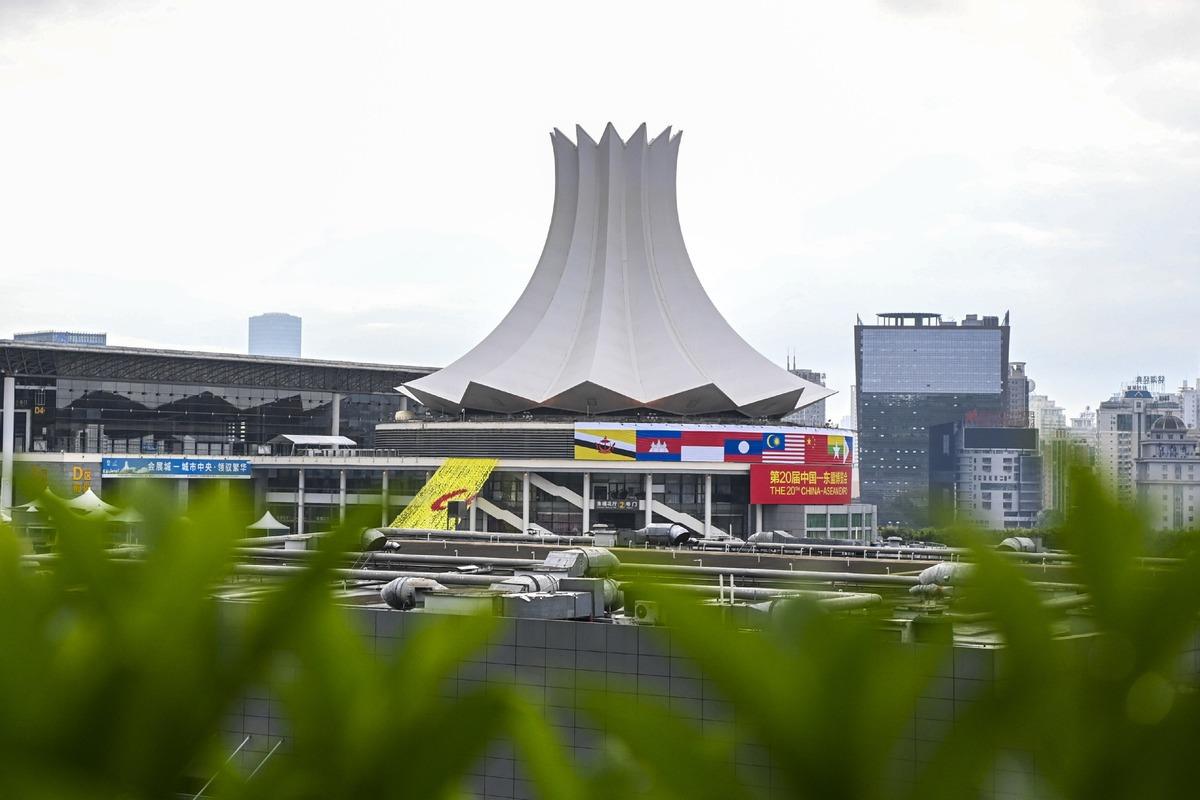 A view of the venue for the 20th China-ASEAN Expo in Nanning, South China's Guangxi Zhuang autonomous region. (PHOTO / XINHUA)
A view of the venue for the 20th China-ASEAN Expo in Nanning, South China's Guangxi Zhuang autonomous region. (PHOTO / XINHUA)
Amid a rosy outlook on bilateral economic relations, officials from the Association of Southeast Asian Nations (ASEAN) said they expect to see greater integration between the bloc and China.
“The total merchandise trade numbers between ASEAN and China is now, for year 2022, $722 billion and I understand that in fact, there is potential for further growth (and) the trade between China and ASEAN will grow by another $438 billion,” said Low Yen Ling, Singapore’s minister of state for the Ministry of Culture, Community and Youth and Ministry of Trade and Industry.
“ASEAN and China can, by embracing all these important principles, really be a good, shiny example to other areas in the world,” said Low, noting the two sides should further enhance their connectivity and exchanges in a fast-changing and volatile global environment.
Low was speaking to the media in Nanning, Southwest China’s Guangxi autonomous region, during the 20th China-ASEAN Expo (CAEXPO), held from Sept 16 to 19.
Under the theme “Work Together for A Harmonious Home and A Shared Future”, this year’s CAEXPO witnessed the signing of a record of 470 investment cooperation projects, with the total investment amounting to 487.3 billion yuan ($66.8 billion), according to Xinhua News Agency.
A number of new initiatives were launched during the CAEXPO and related events, including the unveiling of the China-ASEAN Prosecutorial Information Exchange Center, the Beibu Gulf (Guangxi) Mercantile Exchange Interactive Spot-Futures Trading Platform and the Xinhua (BMEX) China’s Manganes Ore Price Index
A number of new initiatives were launched during the CAEXPO and related events, including the unveiling of the China-ASEAN Prosecutorial Information Exchange Center, the Beibu Gulf (Guangxi) Mercantile Exchange Interactive Spot-Futures Trading Platform and the Xinhua (BMEX) China’s Manganes Ore Price Index.
Since the establishment of dialogue relations between China and ASEAN in 1991, bilateral relations have been continuously deepened with the ties elevated to a comprehensive strategic partnership in 2021.
This year marks the 10th anniversary of Chinese President Xi Jinping’s proposals of building a closer China-ASEAN community with a shared future and the Belt and Road Initiative.
Noting that Singapore was one of the BRI’s early supporters, Low said the initiative is important for fostering regional economic cooperation and the city state can play a role in infrastructure connectivity, financial connectivity, catalyzing third-party collaboration, and providing legal services.
READ MORE: China, ASEAN eye closer ties as expo, summit start
Myanmar Commerce Minister Aung Naing Oo said there are a number of projects to be implemented under the China-Myanmar economic corridor, a key component of bilateral cooperation under the BRI.
Among them, a rail link between Kunming of China’s Yunnan province and Mandalay of central Myanmar will be one of the most important, said Aung Naing Oo, adding that the economic corridor is an impressive project that will benefit the people of Myanmar.
Noting that China is ASEAN’s first free trade partner, Aung Naing Oo said Myanmar is one of the beneficiaries of the free trade cooperation, and he hopes negotiations for version 3.0 of the FTA can be completed earlier than expected.
China and ASEAN has become each other’s largest trading partner, and talks for version 3.0 are underway for a new round of economic and trade cooperation upgrade.
Aung Naing Oo said the Regional Comprehensive Economic Partnership will play a crucial role in future economic cooperation for ASEAN, China and other members.
ALSO READ: BRI hailed as mutually beneficial path
Comprising 15 Asia-Pacific countries, including the 10 ASEAN states and China, RCEP, the world’s largest free trade pact, is now in effect for all its members after it came into force for the Philippines in June.
As China is the biggest trading partner and export market for the Philippines, Trade Undersecretary Ceferino Rodolfo said it is important for his country to nurture this relationship.
Rodolfo said there are two things that the Philippines is looking at the RCEP, namely greater trade facilitation and investment promotion and collaboration.
In addition, Rodolfo said cooperation under the BRI can help enhance connectivity in the flow of goods, and fill gaps in the value chain.
Contact the writers at kelly@chinadailyapac.com


